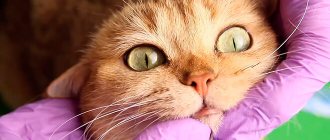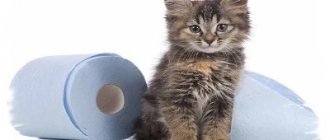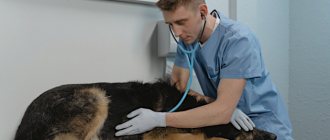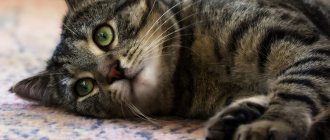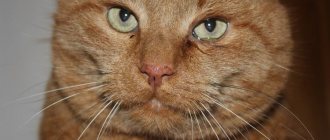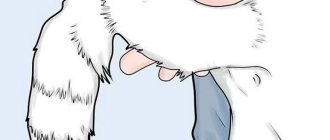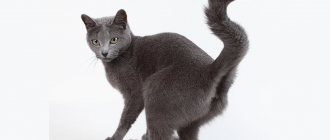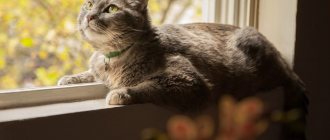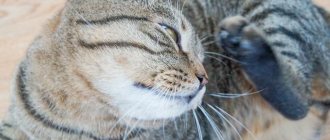It just so happened that when a small light lump appeared in my house, I had exactly two days left to admire the pink freshness of my heels. And then began 8 months of struggle against shitty paws and other unpleasant consequences of diarrhea in this furry animal.
In general, it is cultural, of course, to write - diarrhea, but those who have encountered its variations, alas, do not smell violets, but experience the whole gamut of completely unpleasant emotions and feelings. So I will call this matter by its popular name. Our cat didn’t have diarrhea, but real protracted diarrhea, in several different variations, may the aesthetes forgive me.
From the first minute in the house, the cat looked downright strange. Huge ears, wet nose and constantly hungry eyes. Hryundel attacked the food like a starving man from the Volga region, although he himself seemed to be one of the “decent and cultured” purebred Maine Coons, and not some Vasek from the fence. You can’t keep anger inside yourself, so the cat’s diarrhea also developed rapidly, in proportion to the children’s grub he had eaten.
For the first two days we listened to the breeder’s tales about how the cat’s reaction to the vaccine was a reaction, but then we became desperately short of fresh air in the one-room apartment and we decided to finally discover for ourselves the cause of the cat’s open bowels. And we began to study the question of how to stop our cat’s diarrhea.
Possible reasons
The most common factors causing diarrhea and vomiting in a cat are:
- a sharp change in the usual diet;
- rapid swallowing of food;
- formation of trichobezoars;
- stale food and water;
- binge eating;
- stress.
Usually in such cases, nausea and diarrhea go away quickly and do not require treatment.
On a note. If your indoor cat is vomiting white foam, he may be hungry. The animal's body produces enzymes and gastric juice. They irritate the gastric mucosa and provoke vomiting.
If a cat vomits and diarrhea for a long time, then the cause of this condition may be serious diseases:
- Severe poisoning. Their sources can be medications, poor-quality food, indoor plants and detergents.
- Parasitic infestations. Some types of helminths, when ingested by a cat, quickly cause diarrhea and vomiting.
- Malignant and benign neoplasms in the gastrointestinal tract.
- Diseases of the digestive system (intestinal obstruction, pancreatitis, ulcers, colitis and gastritis).
- Malfunctions of the hormonal or immune system also provoke a disruption of normal metabolism and affect the digestive processes.
- Congenital or acquired diseases of the liver and kidneys.
- Intolerance to some substances or foods. Allergies in cats have a cumulative effect. Therefore, a reaction may suddenly appear to foods that the pet has eaten over a long period.
- Infectious diseases.
- Heat or sunstroke.
- A foreign object swallowed and stuck in the gastrointestinal tract, which, due to its large size or poor location, cannot be released naturally.
- Severe blow or injury to the abdomen. Complicated by the risk of internal bleeding.
Causes of diarrhea in cats and cats
In general, quite a few reasons can cause diarrhea in cats. This includes stress from moving, overeating, intestinal upset due to inappropriate food, poisoning, hyperthyroidism (1), viral infection, including coronavirus (2), bacterial infections and protozoa (cystospora and Giardia), well known to the world worms (helminths) can also participate.
In addition to these reasons, there are also diseases of the gastrointestinal tract (all the same as in humans). Yes, a cat can have gastritis, and it can also cause toilet behavior disorder.
At the same time, diarrhea is also scary because the animal loses weight and the body becomes dehydrated. Therefore, you cannot delay treatment; you can hold out until the moment when the cat’s kidneys fail due to dehydration.
Therefore, if you are not sure about the cause of diarrhea, put on a cat diaper (yes, there are such things) and run to the veterinary clinic to determine the true cause of the diarrhea.
Or at least call the veterinarian to determine from the symptoms what measures need to be taken now.
– The main causes of diarrhea in cats: helminthic infestation, gastrointestinal disorders due to poor diet, systemic intoxication (drug overdose, non-compliance with dosages, etc.), viral diseases of cats, for example, panleukopenia (3) or leukemia, as well as stress, diseases of the liver and pancreas,” says Ivan Malyshev, veterinarian at the PriVet clinic.
Photo: pixabay.com
Primary and secondary symptoms
The main sign of diarrhea in a cat is loose stool. In addition to this, the animal may experience other symptoms:
- flatulence;
- frequent attempts to defecate;
- mucus and blood in excrement.
In addition, in an adult animal or kitten, diarrhea and vomiting are often accompanied by the following secondary symptoms:
- lethargy and apathy;
- gagging;
- fever;
- dehydration;
- lack of appetite;
- weight loss.
Popular questions and answers
We also addressed a number of questions about diarrhea in cats and cats to veterinarian Ivan Malyshev - he gave a number of tips to animal owners.
How long can diarrhea last in a cat?
If your cat just gobbled up your candy, then usually the diarrhea will stop within 1 day, provided that you gave him sorbents and he goes hungry at least until the evening. If this is a symptom or a viral infection, then the diarrhea may not end on its own - treatment is needed.
What to do if a cat’s diarrhea is accompanied by vomiting?
Vomiting and diarrhea can be both a sign of poisoning and a systemic disorder. This is the most common clinical picture, ranging from obstruction to oncology.
What does yellow diarrhea mean in a cat?
Yellow diarrhea - for any diseases of the parenchyma (especially the liver). This is already a hint of a serious illness in your pet.
What does green diarrhea mean in a cat?
Green – putrefactive decay in the intestines, most often resulting from low-quality feed, rotten products. May appear due to poisoning in an animal.
What does white diarrhea mean in a cat?
White diarrhea is very bad, you need to urgently take it to the hospital. This is a symptom of blockage of the bile ducts and the formation of bile in the liver.
Why does diarrhea in cats come from water?
Probably the safest (if I may say so) type of intestinal disorder in cats, because it is usually associated with poisoning with low-quality food or unusual food for the animal. Unless accompanied by other symptoms such as mucus, blood in the stool, loss of appetite, weight loss, lethargy and vomiting, diarrhea is usually a one-time intestinal protest in the animal.
Why does my cat have diarrhea with mucus?
Diarrhea with mucus is a very dangerous thing. This is one of the first symptoms of intestinal inflammation in an animal, which means that pathogenic bacteria are multiplying in it. If there are several animals in the house, it is better to isolate the animal with such signs, make a separate toilet and bowls so that other animals do not become infected. For example, viral peritonitis in cats, a fatal disease, has one of these symptoms.
How dangerous is bloody diarrhea in cats?
Bloody diarrhea is often a sign of a fatal disease in cats, such as: inflammation in the large intestine, tumors; poisoning by poisons and chemicals, household chemicals; traumatic injuries in the rectum, intestinal rupture; acute pancreatitis; Panleukopenia is the most dangerous viral disease in cats.
Can diarrhea in cats lead to dehydration?
Maybe. Therefore, you need to give the animal water (even forcibly) or give it an IV under the supervision of a veterinarian. Well, be sure to fast for a day so that the animal’s body can rest and cleanse itself.
First aid at home
If your cat has diarrhea and vomiting, she needs to provide first aid:
- Compliance with drinking regime. The first thing to do at home if your cat has diarrhea and vomiting is to give your pet bottled or boiled water. This will help prevent the development of dehydration. If the cat refuses to drink on its own, then after each trip to the toilet it must be force-fed using a syringe without a needle.
- Following a fasting diet. Feeding a sick cat with diarrhea and vomiting is prohibited. Fasting will help minimize the burden on the digestive organs.
- Removing toxins. Diarrhea and vomiting in a cat cause severe intoxication of the body. To avoid this, the animal can be given 2-3 tablets of activated carbon. They must first be ground into powder and dissolved in a small volume of water. If necessary, activated carbon can be replaced with a bag of Smecta. Before giving the cat the medicine, it must be diluted in water.
Acute attack of diarrhea
A small kitten runs to the litter box quite often - this is normal if the stool has a normal color, smell and consistency. Changes in food, imperfections in the gastrointestinal tract, physical or nervous “overload,” overheating or, conversely, hypothermia, the first day of vaccination – all this often leads to diarrhea in a cat.
The appearance of mucus, blood in the stool, and changes in density should alert the owner.
In an old cat, alternating constipation with isolated cases of diarrhea is an almost normal phenomenon associated with decreased intestinal motility due to age. Preventive advice from a veterinarian, correction of diet and nutrition, encouragement to do more physical activity and possible use of appropriate medications will help here.
In adult healthy animals, a short-term "stomach upset" called "acute diarrhea" is most common. Acute diarrhea begins suddenly, without external changes in the cat’s behavior.
Diarrhea with acute diarrhea does not have a pronounced, sharp putrefactive odor, and ends just as suddenly (in a day or two). This can be attributed to the natural cleansing of the intestines, characteristic of all types of living beings on Earth.
Chronic diarrhea (diarrhea), accompanied by the loss of large amounts of water from the body, flatulence, stench, discoloration of feces, blood clots and mucus in the feces, is dangerous for the animal because it can last for weeks or even months.
Diagnostic methods
Only a specialist can identify the exact cause of diarrhea and vomiting in a cat. To make a diagnosis, the following are usually prescribed:
- general blood analysis;
- biochemical study of vomit and feces;
- smear from the rectum and oral cavity;
- X-ray and ultrasound of the abdominal cavity;
- culture for salmonellosis;
- study of markers for the presence of pancreatitis or pancreatic insufficiency.
Also, during the initial appointment, the veterinarian asks the owner about the presence of vaccinations, symptoms, nutrition and duration of illness.
Chronic diarrhea - secretory diarrhea
People say about secretory diarrhea: “like a clove” or “just water.” If a person with chronic diarrhea experiences pain, dizziness, weakness, nausea and dry throat, then rest assured that your cat is not feeling any better.
Changes in intestinal function occur due to impaired absorption and transport of water through its lumens. The water necessary for organizing the normal functioning of all body systems is simply excreted through copious loose stools. Rapid dehydration occurs, which can lead to the death of the animal.
Defecation with secretory diarrhea is painless, but brings only short-term relief, quickly replaced by pain due to accumulating gases and painful spasms.
Attention!
If watery stools turn brown-green or become deep yellow (to orange), this indicates a decrease in the contractile functions of the bladder walls and the absorption of bile secretions - hologenic diarrhea.
The appearance of white stool directly indicates the degeneration of liver tissue: jaundice, cirrhosis and cancer.
Bilirubin not processed by the liver provokes pathology of the intestines, expressed in random attacks of diarrhea, which owners mistake for an acute variant and try to find “the best cure for diarrhea for cats, because THIS no longer helps!”
Treatment options
Diarrhea and vomiting in a cat need to be treated comprehensively. Therapy should include special care, diet and medication. Medicines are prescribed to a cat only after receiving the results of examinations and accurately establishing the cause.
Depending on the diagnosis, the following is prescribed:
- anthelmintic drugs;
- antibiotics;
- antihistamines;
- enzymes;
- corticosteroids;
- vitamin complexes.
To remove toxins and restore intestinal microflora during diarrhea and vomiting, the cat is given the following medications:
- Lactofiltrum;
- Phosphalugel;
- Hilak Forte.
Important! Self-treatment of diarrhea and vomiting in a cat is unsafe for the health of the animal. Therefore, all appointments must be made by a qualified veterinarian.
During the first days of illness, the pet is not given anything to eat. The duration of fasting is determined depending on the severity of the pet’s condition. You need to return to your usual diet gradually. At first, the cat can be fed with special food to normalize the digestive system or rice with pieces of boiled chicken.
Gradually, you can gradually add your usual food to your food.
In some situations, when a cat has diarrhea and vomiting, surgery cannot be avoided. The operation is prescribed:
- when a foreign object is detected in the cat’s gastrointestinal tract;
- oncological diseases of the abdominal organs;
- identifying ulcers and erosions in the stomach or intestines.
Nutrition
The cat should not be allowed to go hungry for more than 24 hours. From the 2nd day of illness, the pet is fed small portions at regular intervals.
Diet rules for diarrhea with blood and mucus:
- Give small portions every 2 hours.
- Use fresh products.
- Steamed or boiled. Add a little salt.
- Do not feed raw meat.
- Be sure to drink enough water.
- Food should be warm.
If the cat has been eating dry food, replace it with wet food. Reduce the portion. You can change your regular food to a diet line.
What you can do:
- boiled lean meat;
- boiled fish;
- baby meat food;
- porridge cooked in water;
- pasta.
What not to do:
- fatty and fried foods;
- raw fish and meat;
- bones;
- dairy products.
The diet is maintained during the illness and 2 weeks after recovery. This is necessary to restore intestinal function.
Prevention measures
To avoid possible problems with the digestive system, the kitten must get used to a certain diet from childhood. To prevent diarrhea and vomiting in a cat, you should adhere to the following recommendations:
- The animal should be fed only fresh and high-quality food.
- New foods should be introduced into your cat's diet gradually.
- Periodically, the cat needs to be given pastes to remove hair.
- You cannot mix different types of food.
- Cat bowls need to be kept clean.
- You cannot feed the cat with leftovers from the owner's table.
- It is necessary to prevent contact between pets and street animals.
- Routine vaccination and antiparasitic treatments should not be neglected.
Diarrhea and vomiting in cats are the result of many serious diseases. Therefore, if your pet is vomiting and does not eat, it needs to be shown to a doctor. The veterinarian will determine the exact cause of the ailment and write a treatment plan.
